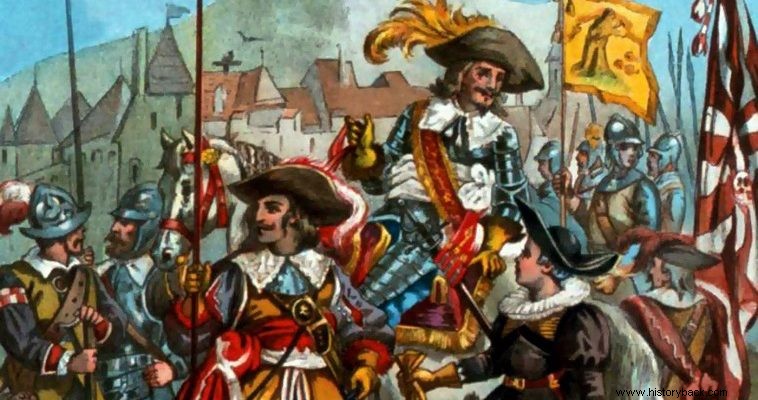
The Thirty Years War (1618-48) was one of the most destructive in world history. The Habsburg army fought hard in this conflict. At a time when there were still no regular armies, at least in today's sense of the term, armies were formed during wars and disbanded at their end.
This practice also applied to the Habsburg Army. Like all European armies of the time, the army consisted of cavalry, infantry and artillery weapons.
The infantry was not yet, at that time, the decisive weapon of the struggle. This role was still held by the cavalry, but constantly reduced. The infantry, with the increasing proportion of firearms in its ranks, was day by day gaining an increased role on the battlefield. It is worth noting that during the Thirty Years' War the composition, organization and tactical use of the Imperial infantry changed drastically.
When the war broke out the infantry's basic battle formation was the quarter. It was a compact mixed formation of men armed with muskets and sarissas in a ratio of 1:1 to 3:2 arrayed up to 50 cubits deep with the sarissaphores in the center and the musketeers at the wings or four "corners" of the sarissaphorus phalanx.
Each quarter was equivalent to a regiment and consisted of 10 companies each of which had a strength of up to 300 men. A small number of men were armed with spears and sickles.
The musketeers lined up in formation up to 10 yoke deep and charged against alternating yokes, armed with a musket with a fuse firing system. For safety reasons, a gap of approximately 1 m was left between each musketeer.
In the event of an enemy cavalry charge against them, the sarissaphoros formed a kind of moving square. The musketeers fled under the protection of the sarissas, maintaining the ability to shoot.
However, these solid monolithic formations were an ideal target for enemy fire and especially for artillery. Thus gradually the imperial tertias became smaller and "lighter", with an average strength of 1,500 men, copying the Dutch and Swedish infantry brigades, in some ways.
The quarters of the famous general Johann Zerklaes von Tilly that faced the Swedes at Breidefeld in 1631 had musketeers and sarissaries in a ratio of 2:1 and had an average strength of about 1,500 men. Despite the defeats by the Swedes, however, the imperial infantry never adopted, exactly, the Swedish model.
Musketeers of the time carried a heavy musket that was ignited by a fuse. It was a heavy weapon that was required to rest on a special support when firing. At the end of the period, however, lighter models that did not need a support were also used.
Musketeers usually wore a thick leather tunic, without sleeves, which protected against sword blows. Crossed they carried the telamon where the prepared shots (bullet and gunpowder in the right proportion) and a straight, long sword were carried. They usually also brought a manual.
Sarrissophores wore 1/2 armor (front and rear half breastplate), or 3/4 armor (as above with additional thigh and arm breastplates), or simply a leather tunic like musketeers. The sarrisophores also carried a helmet and a sword. Each company carried a flag and was composed of musketeers and sarissaries. However, in the battle, the sarissaries gathered in the center and the musketeers on the wings of the formation.
Non-commissioned officers and officers carried a sword and lance or spear, respectively, and cloth belts indicative of their rank. Uniforms in today's sense did not exist. Each regiment could have shirts of different colors. However, the dominant colors were red, ocher and deep red.
In the battle against an infantry opponent, the musketeers took it upon themselves to weaken the opponent with their fire. Then the sarrisophores rushed out judging the result.
